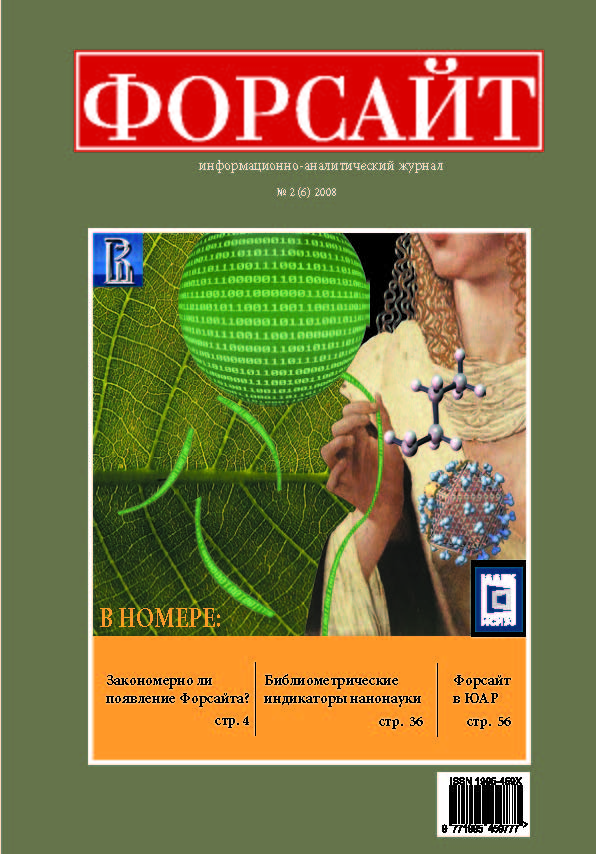Abstract
The proposed material is unique because it evaluates the results of a Foresight project after the expiry of the planned time horizon - 10 years. It is shown that Foresight had very limited impact on national innovation policy. Although it contributed to the development of consensus among stakeholders, increased their awareness and public participation, however in identifying new technological purposes its success has been far more modest. The author concludes that thoroughly planned activities under Foresight would be much more in favor of innovation policy. Particularly it is needed to clarify the motivations of key actors that would require further research of their behavior.
References
ANC. Reconstruction and Development Programme. Johannesburg: African National Congress, 1994.
Burrell G., Morgan G. Sociological Paradigms and Organizational Analysis (3rd ed). Aldershot: Gower Publishing, 1987.
DACST. A National Biotechnology Strategy for South Africa. Pretoria: Department of Arts, Culture, Science and Technology, 2001.
DACST. Foresight Synthesis Report: Dawn of the African Century. Pretoria: Department of Arts, Culture, Science and Technology, 1999.
DME. Nuclear Energy Policy. Pretoria: Department of Minerals and Energy, 2007.
DST. Innovation towards a Knowledge-based Economy: Ten Year Plan for South Africa. Pretoria: Department of Science and Technology, 2007.
DST. The National Research and Development Strategy. Pretoria: Department of Science and Technology, 2002.
Erwin A. Pebble Bed Modular Reactor Supplier Conference (24/08/2005). Retrieved from http://www.polity.org.za/article.php?a_id=72997.
Feinstein A. After the Party. Johannesburg: Jonathan Ball Publishers, 2007.
HSRC, 2008. http://www.hsrc.ac.za/CCUP-RnD-7.phtml.
Hussler C., Ronde P. The impact of cognitive communities on the diffusion of academic knowledge: Evidence from the networks of inventors of a French university / Research Policy, Elsevier, March 2007, v. 36, № 2, p. 288-302.
Kahn M. J. The South African national system of innovation after Apartheid: from constructed crisis to constructed advantage? / Science and Public Policy, 2006, v. 33, № 2, p.125-136.
Kahn M. J., Gastrow M. Pharmacologically active: clinical trials and the pharmaceutical industry / South African Medical Journal, 2008, v. 95, №3, p. 630-632.
Kantey M. Planning for the future: The energy question. Paper presented at the Harold Wolpe Memorial Trust's 52nd Open Dialogue 25 May 2006, University of Cape Town. Retrieved from http://www.wolpetrust.org.za/dialogue2006/CT052006kantey_paper.pdf.
Kim L. Crisis construction and organization learning: capacity building is catching up at Hyundai Motor / Organization Science, v. 9, № 4, 1998.
Lundvall B.-Е. Innovation, growth and social cohesion. Cheltenham: Edward Elgar Publishers, 2002.
Mani S. Government, Innovation and Technology Policy. An International Comparative Analysis. Cheltenham UK: Edward Elgar Publishers, 2002.
National industrial policy framework gives clearer picture. DTI, 2007. Retrieved from http://www.sabinet.co.za/sabinetlaw/news_par478.html.
Nelson R. R., Winter S. G. An Evolutionary Model of Economic Change. Cambridge, MA: Harvard University Press, 1992.
OECD. Review of South Africa's Innovation Policy. Working paper DSTI/STP(2007)12. Paris: Organisation for Economic Co-operation and Development, 2007.
Perez C. Technological Revolutions and Financial Capital. Cheltenham: Edward Elgar Publishers, 2002.
RSA. Constitution of the Republic of South Africa. Act № 20 of 1996. Pretoria: Government Printer, 1996.
RSA. Ten Year Review. Pretoria: The Presidency, 2004 (unpublished).
RSA. The Growth, Employment and Redistribution Strategy. Pretoria: Government Printer, 1995.

This work is licensed under a Creative Commons Attribution 4.0 International License.

